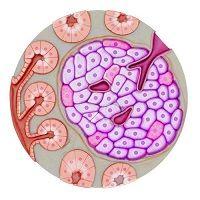Article
Short Endoscopic Secretin Testing Can Identify Exocrine Pancreatic Insufficiency in Patients with Cystic Fibrosis
Author(s):
New research indicates that short endoscopic secretin tests can accurately differentiate cystic fibrosis patients with exocrine pancreatic insufficiency from those who retain exocrine pancreatic function.

New research indicates that short endoscopic secretin tests can accurately differentiate cystic fibrosis patients with exocrine pancreatic insufficiency from those who retain exocrine pancreatic function.
Researchers gave intravenous secretin to 31 cystic fibrosis patients and 25 healthy controls and, within the next 30 to 45 minutes, used endoscopes to collect duodenal juice. They then analyzed the duodenal juice to determine the concentration of HCO3 and pancreatic enzymes. They also analyzed patient stool to look for fecal elastase.
Both the stool and duodenal juice analyses revealed that 13 of the cystic fibrosis patients maintained exocrine pancreatic sufficiency, while the remaining 18 were not making enough digestive enzymes. Indeed, the duodenal juice analysis found distinctly differentiated patterns of bicarbonate concentrations and enzyme activities in all 3 types of subject: the cystic fibrosis patients with pancreatic function, the cystic fibrosis patients with pancreatic insufficiency and the healthy volunteers (P < 0.001). The study also found a strong association between severe cystic fibrosis genotype in both alleles and pancreatic insufficient phenotype (P < 0.001).
“Short endoscopic secretin tests for exocrine pancreatic function are not properly evaluated in cystic fibrosis,” the study team wrote in Pancreas. “Pancreatic exocrine insufficient cystic fibrosis patients could be differentiated from exocrine sufficient patients and healthy controls using short endoscopic secretin test.”
The new study was conducted by the same research team that wrote earlier this year about its efforts to assess exocrine pancreatic failure via secretin-stimulated ultrasonography.
In that study, which was published in the Scandinavian Journal of Gastroenterology, the research team performed transabdominal ultrasonography before, during and 15 minutes after patients received intravenous secretin. Cystic fibrosis patients with pancreatic insufficiency, as well as patients whose chronic pancreatitis had triggered pancreatic insufficiency, showed less duodenal fluid filling compared to healthy controls and cystic fibrosis patients that maintained pancreatic function (p < 0.001).
The researchers also checked to see whether they could predict pancreatic insufficiency by using the ultrasound to measure the diameter of each patient’s Wirsung duct, but they found this method to ineffective for all but the most severe cases of pancreatic failure.
“Secretin-stimulated ultrasonography can be used to assess pancreatic fluid flow and may be combined with endoscopic short test in the evaluation of exocrine pancreatic function,” wrote the authors of the study, who are based in Bergen, Norway. “Fluid filling in the descending part of duodenum was the most accurate predictor of pancreatic insufficiency in both patient groups. The test demonstrated better diagnostic accuracy diagnosing exocrine pancreatic failure in the cystic fibrosis patients than in chronic pancreatitis patients.”
The study team’s search for new ways to measure pancreatic function in patients with cystic fibrosis stems from the tendency of the disease to progressively reduce the ability of the pancreas the pancreas to help digest food. Each patient’s exocrine sufficiency must be tested repeatedly over the years, generally through a comprehensive laboratory evaluation that consists of several different tests. An accurate way to determine pancreatic function via a single test would save both time and money.
Some studies have suggested that MRI scans can diagnose pancreatic insufficiency with good accuracy, but the researchers from Norway say that ultrasound would be a preferable alternative because it is far cheaper and because it does not expose patients to radiation.




